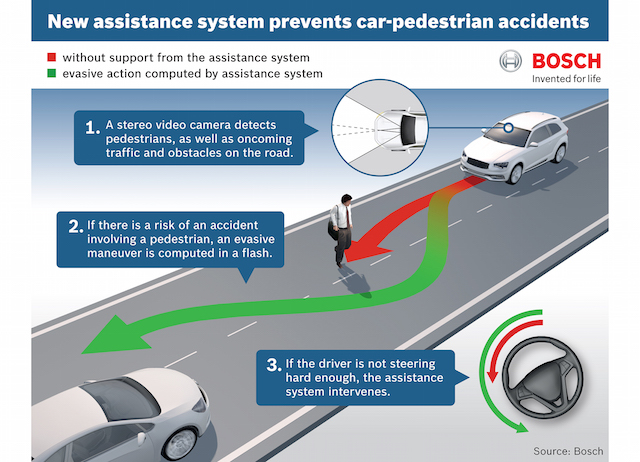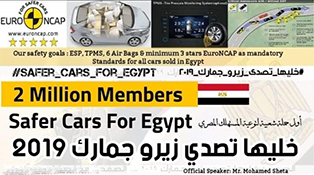FIA
Day 1 of 4th United Nations Global Road Safety Week - How FIA and United Nations team up to Save Lives - #slowdown
Therefore we at Auto Arabia teamed up with the Automobile & Touring Club of Egypt ATCE in order to raise the public and media awareness about this extremely important issue, as our part and contribution to the 4th United Nations Global Road Safety Week and to the efforts of the FIA in improving the road safety situation worldwide.
During this Global Road Safety Week we will see Auto Arabia’s editor-in-chief Mohamed Sheta cooperating closely with the Automobile & Touring Club of Egypt and its Traffic & Tourism Committee. Sheta is not only an influential automotive journalist and well-known jury-member in six internationally-renowned automotive awards with over 25 years of experience in the automotive, motorsport and media sector, but he is also an internationally-acknowledged road safety advocate speaking regularly in fluent German, Arabic, and English at regional and international automotive and road safety conferences.
Sheta will be talking daily here on autoarabia.org and on several radio and TV channels about the most challenging problems and obsta
This extensive media activity is aimed primarily at reaching millions of road users, internet users, TV viewers and radio listeners but at the same time will also reach the political decision-makers and stake-holders.
On each day of this road safety week Mohamed Sheta will tackle a different road safety topic/problem, and explain how to adapt effective solution for those road safety problems based on the current circumstances in Egypt and based on the behavior and understanding of the Egyptian road user.
During the seven days of the 4th UN Global Road Safety week Sheta will talk about the following seven topics:
- 08.05.2017: Risks of speeding for passenger car drivers
- 09.05.2017: Risks of speeding for motorcycle riders
- 10.06.2017: Risks of speeding for microbus, minibus, public transportation bus, tourism bus and taxi drivers
- 11.06.2017: Risks of speeding for Light Commercial Vehicle drivers
- 12.06.2017: Risks of speeding for Heavy Goods Vehicle drivers
- 13.05.2017: The role of the government, the private sector, the NGOs, the public & private schools, the public & private universities and the law enforcement authorities
- 14.05.2017: The importance of the use of modern technology and ITS by the law enforcement and the importance of active and passive safety features in the passenger cars, motorcycles, buses, LCVs and HGV for reducing the braking distances
So today on the 8th of May 2017, the first day of the 4th UN Global Road Safety week, Sheta will be talking about the risks of speeding for passenger cars and how slowing down will definitely save lives. Let us see what he had to say about this topic:
‘Anybody who plans to buy a new car should ALWAYS look for a car with the latest active and passive safety features. And I am not talking about ABS and airbags, as those life-saving features already became standard in Europe since the 80’ and 90’. I am talking about the live-saving Electronic Stability Program (ESP) or the Tire Pressure Monitoring System (TPMS), which also became mandatory since November 2011 in the European Union.
It is unacceptable that only 3-5 % of the estimated nine million vehicles (source: Traffic Department / Ministry of Interior) driving on Egyptian roads are equipped with the latest active and passive safety features such as ESP and TPMS.
Also the Head-Up Display (HUD) is extremely important for better road safety records, although many consumers mistakenly consider it a luxury or comfort option. Having the important things such as speed limit, current speed, navigation arrows indicating the next corner direction and many more displayed right in front of you on the windscreen through Head-Up Display will ensure that you always stay below the speed limit. Staying below the speed limit or slowing down when you cross the speed limit simply means you are saving lives!
Speed limits can be displayed on the HUD or in the dashboard either through a radar scanner at the front of the car or through the GPS / Nav-Sat system, where the speed limits must be either stored on the hard-disk / DVD or updated online while the car is moving. In any case, a modern car with modern technology features is a must if you want to offer safety for you and your friends or family members riding with you in the car.
Another important safety feature is the Night-vision option, which unfortunately is only available in some expensive luxury models such as the Mercedes S-Class. Nevertheless this important feature is extremely important as it shows you obstacles during your night rides, which you would not see with your bare eyes.
And when you buy a new or even used car always try to make sure that it has at least 4 or 5 stars in the benchmark-setting European New Car Assessment Program, also known as the EuroNCAP, to ensure a minimum of active and passive safety features. And note that the EuroNCAP differs significantly from the Chinese NCAP or the Latin NCAP. For example a car achieving 5-stars in the ChinaNCAP car could maybe only get 3-stars rating in the EuroNCAP.
Needless to say, stay away from one-star, two-stars and surely also from zero-stars cars like the Chevrolet Aveo sold in Egypt.
But all the above-mentioned safety features should never distract you from obeying the speed limits or even stay below the speed limit, especially around schools, hospitals, around building sites or when passing through construction areas on the road.
You might think that driving with 40km/h or 50km/h in a 30km/h-speed-limited area would not make a big difference. Well, you are utterly wrong! It actually makes a HUGE difference.
To be more precise:
- If you drive 20mph or 32 km/h then your braking distance is 12 meters or 40 feet !
- If you drive 30mph or 48 km/h then your braking distance increases 23 meters or 75 feet !!
- If you drive 50mph or 80 km/h then your braking distance increases significantly to 53 meters or 175 feet !!!
- And if you drive 70mph or 112 km/h then your braking distance is almost 10 times more, 96 meters or 315 feet to be exact !!!!
Of course your braking distance also increases significantly if your tires are worn off (see picture).
And last but not least, of course the braking distance rises drastically when you have worn shocks and struts as well.
Therefore my recommendations in all cases: #slowdown and save lives’
AA
08.05.2017
Cairo
Related articles:
#SaferCarsForEgypt
 Want to sell your used car or buy one? Then check out our new used car market section
here!
Want to sell your used car or buy one? Then check out our new used car market section
here!
 Looking for a good service center or aftersales customer service? Did you have any bad experience with your car dealer or service center? Then check our 'automotive evaluation charts'
here!
Looking for a good service center or aftersales customer service? Did you have any bad experience with your car dealer or service center? Then check our 'automotive evaluation charts'
here!
Is Egyptian car market corrupt or collapsing?

Is the Egyptian car market collapsing or is it just a corrupt and unprofessional car market?
This is surely one of the most asked questions these days. Everybody is asking ...
AutoArabia Consulting
Middle East Car of the Year

Read more
Crash Test Results

Subscribe







 Volvo Cars receives highest possible sustainability ...
Volvo Cars receives highest possible sustainability ... Nicolas Fuchs steers Borgward BX7 DKR to 3rd place at ...
Nicolas Fuchs steers Borgward BX7 DKR to 3rd place at ... VOLVO XC60 IS THE NEW 2018 WORLD CAR OF THE YEAR
VOLVO XC60 IS THE NEW 2018 WORLD CAR OF THE YEAR Jaguar Middle East launches F-PACE 2.0 WITH NEW 250PS ...
Jaguar Middle East launches F-PACE 2.0 WITH NEW 250PS ... Egypt-Exclusive: First Drive of Volvo XC60 – Is it ...
Egypt-Exclusive: First Drive of Volvo XC60 – Is it ... FIA OFFICIAL STATEMENT FOLLOWING THE 2017 AZERBAIJAN F1 ...
FIA OFFICIAL STATEMENT FOLLOWING THE 2017 AZERBAIJAN F1 ... Volvo Cars safety experts receive prestigious award ...
Volvo Cars safety experts receive prestigious award ... Geneva Show 2017: All-new Volvo XC60 SUV will ...
Geneva Show 2017: All-new Volvo XC60 SUV will ... Formula E 2017 season: Renault e.dams win opening race ...
Formula E 2017 season: Renault e.dams win opening race ... XC90 and 90 series help Volvo Cars report impressive ...
XC90 and 90 series help Volvo Cars report impressive ...




